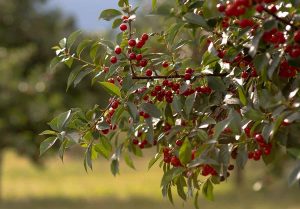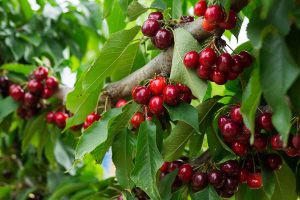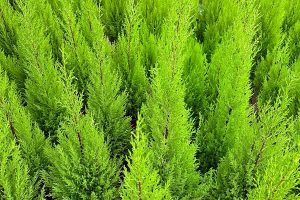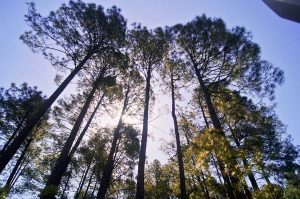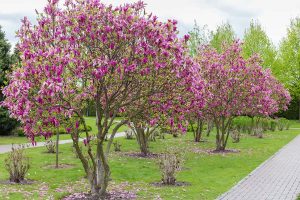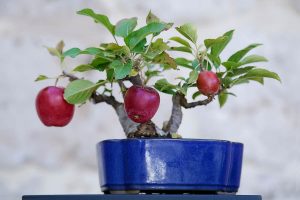Trees with orange berries add a visual statement to the landscape, with bright fruits that contrast against a background of green foliage. Read on for the best types of trees with orange berries.
Table of Contents
Crabapple ‘Professor Sprenger’
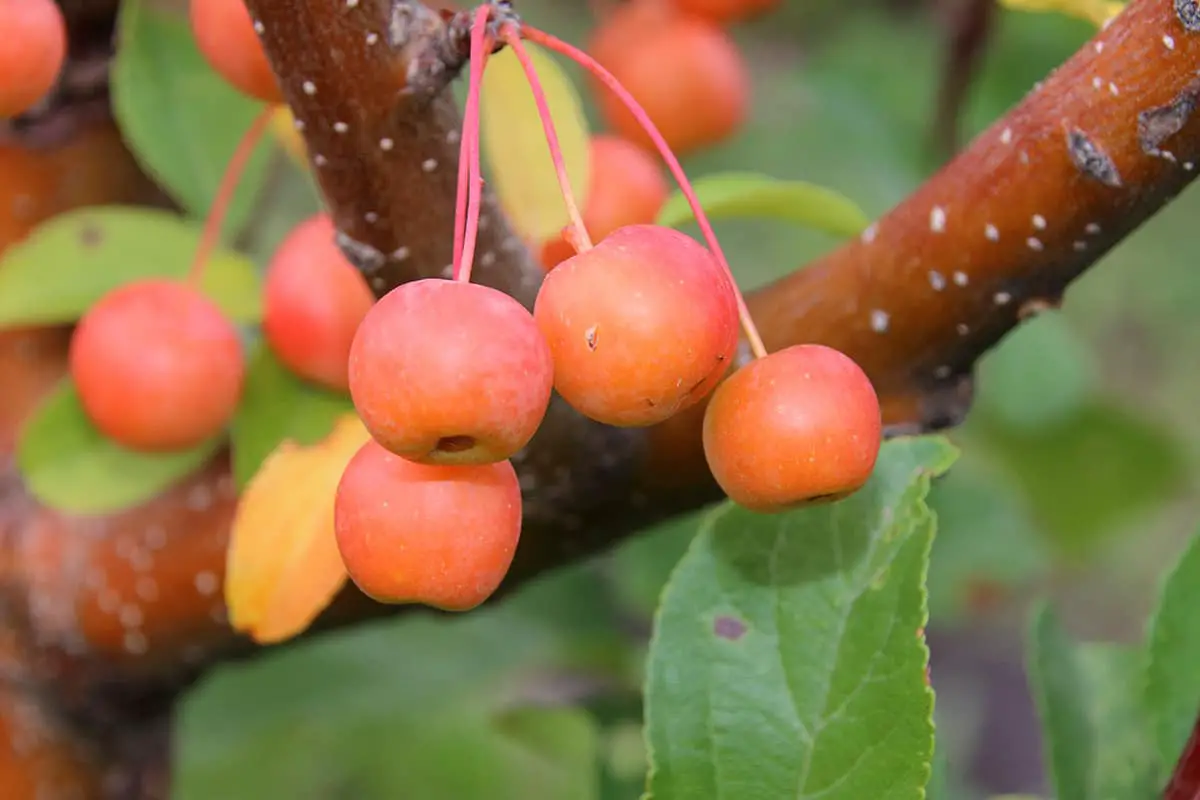
- Botanical name: Malus sylvestris ‘Professor Sprenger’
- Common names: Crabapple,
- Plant family: Rosaceae
- USDA hardiness zone: 4 – 7
- Mature height: Up to 20 feet
- Mature spread: Up to 20 feet
This variety of Crabapple trees is medium in size and deciduous. It blooms in the middle of spring, with flowers arriving on bare branches at around the same time as the leaves. The flowers open out from pink buds, emerging into pretty white blossoms.
The flowers remain for several months and, by early fall, will have developed into clusters of glossy orange berries. Each berry measures around half an inch across and will remain dangling from the tree into winter, at which time birds will descend on the berries to devour them.
The foliage of the tree is fresh green through spring and summer and will warm up to shades of orange and yellow in the fall to match the orange berries.
This tree grows easily with little care and maintenance. It thrives in full sun and prefers soils that are well draining and quite rich.
Whitebeam
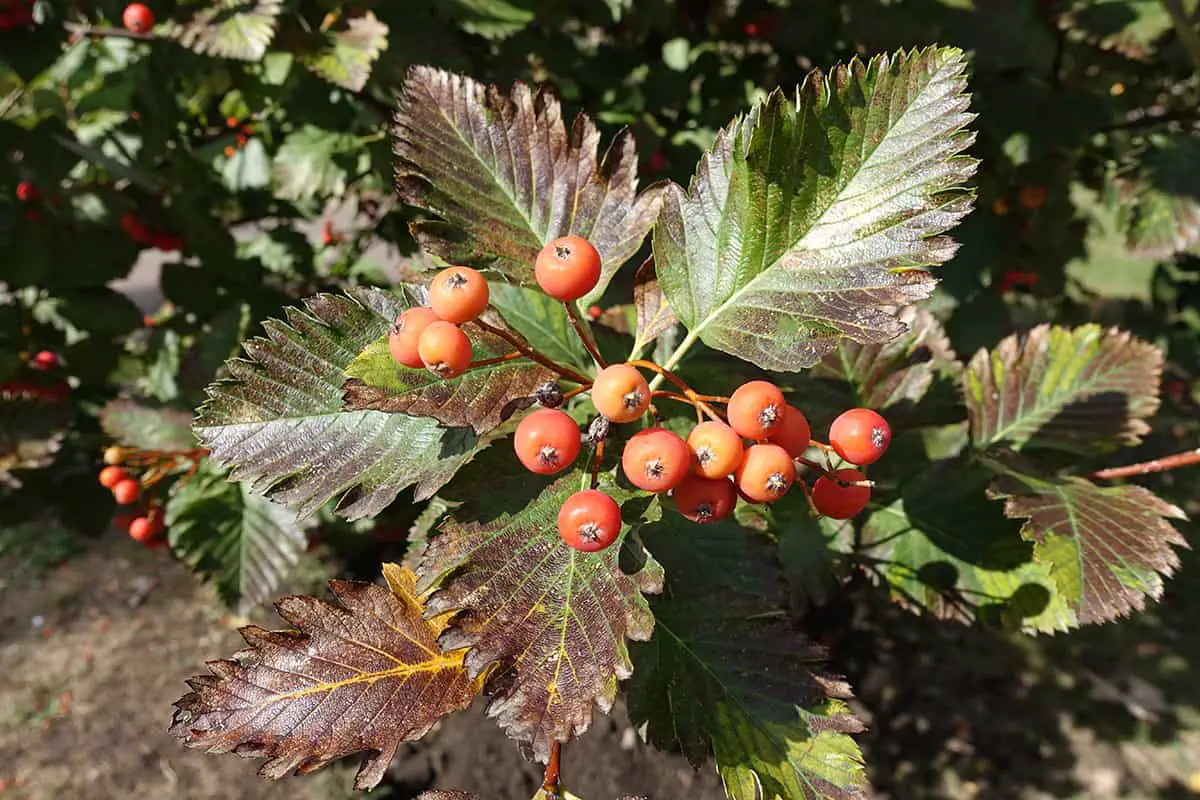
- Botanical name: Sorbus aria
- Common names: Whitebeam,
- Plant family: Rosaceae
- USDA hardiness zone: 4 – 7
- Mature height: Up to 50 feet
- Mature spread: Up to 25 feet
The Whitebeam tree is native to most of Europe, including the UK, as well as some of North Africa and Asia. It is a deciduous tree with a dome-shaped canopy and upwards-reaching branches. The foliage of the tree is broad and medium green, with each leaf measuring around 4 inches in length.
The leaves have irregularly toothed margins and coarse white hair on their undersides. The tree produces clusters of small white flowers in spring, and these are followed by clusters of showy berries.
Many varieties of Whitebeam produce red berries, but there are some notable cultivars that produce orange berries. Orange berry varieties include ‘Lutescens’, which has won the Award of Garden Merit from the Royal Horticultural Society, and ‘Apricot Queen’, which boasts masses of pink-orange berries in fall. The berries on the Whitebeam tree can last right through to winter, and they are safe to eat once ripe.
Whitebeam trees grow well in fertile, well-draining soils and prefer full sun or partial shade.
Rowan Tree
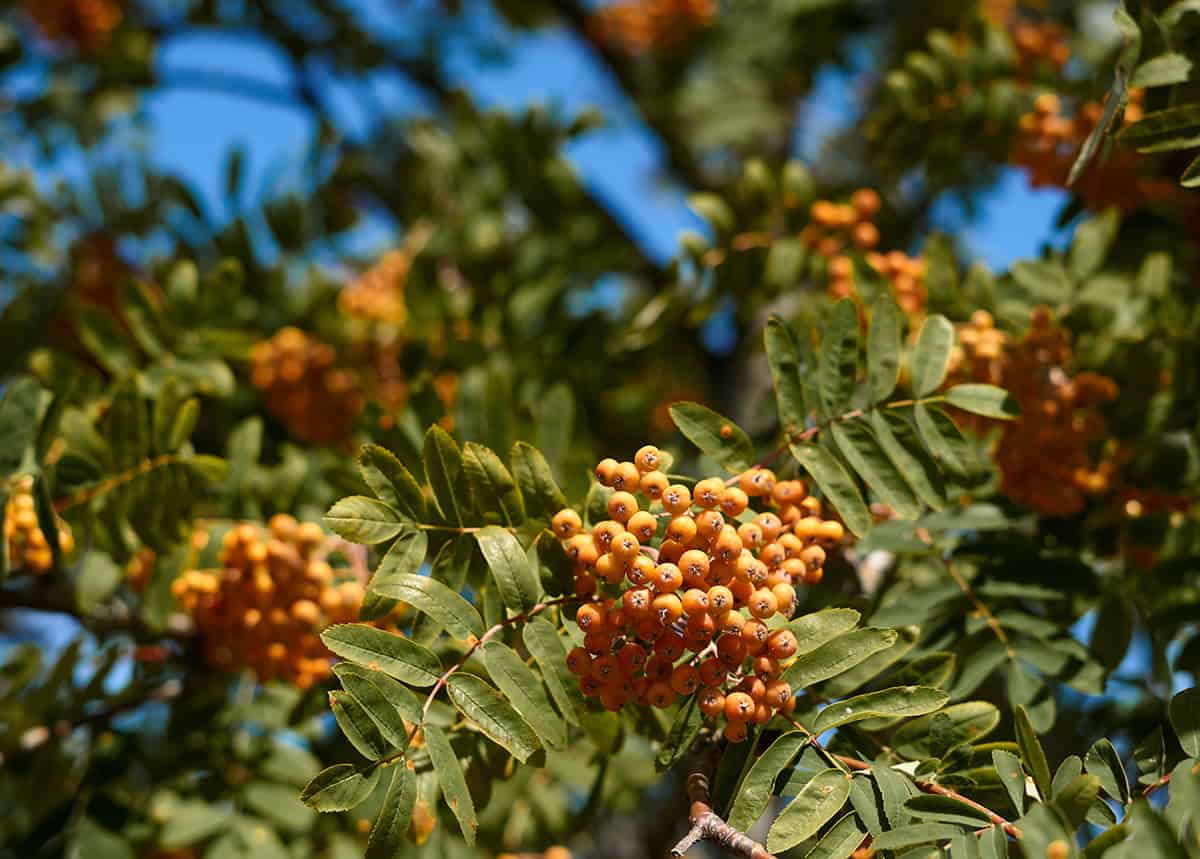
- Botanical name: Sorbus aucuparia
- Common names: Mountain Ash
- Plant family: Rosaceae
- USDA hardiness zone: 3 – 6
- Mature height: Up to 40 feet
- Mature spread: Up to 20 feet
Like the Whitebeam tree, the Rowan tree belongs to the Sorbus genus. In Europe, it is known as the Rowan tree, while in North America, it is more commonly known as the Mountain Ash. It is a deciduous tree with an oval canopy when young, which takes a more rounded shape as the tree matures.
The attractive leaves are pinnately arranged and have uniform toothed margins. Leaves emerge medium green and darken through summer before taking on yellow, red, and purple shades in the fall and subsequently dropping to the ground.
The Rowan tree puts on a dazzling floral display in late spring, with a profusion of white flowers held in dense clusters. These mature into berries that vary in color from bright orange to orange-red.
The berries are enormously popular with birds, which disperse their seeds. The berries can also be used to make jams and jellies. Through winter, the bare branches can be seen, and the smooth, gray bark is appreciated. Despite being deciduous, the Rowan tree maintains an interest in the landscape throughout every season.
Rowan trees grow easily in well-draining, acidic soils. They prefer full sun and can be propagated from seed or softwood cuttings. The tree has become invasive in some US states, where native species should take preference for new planting.
Kumquat Tree
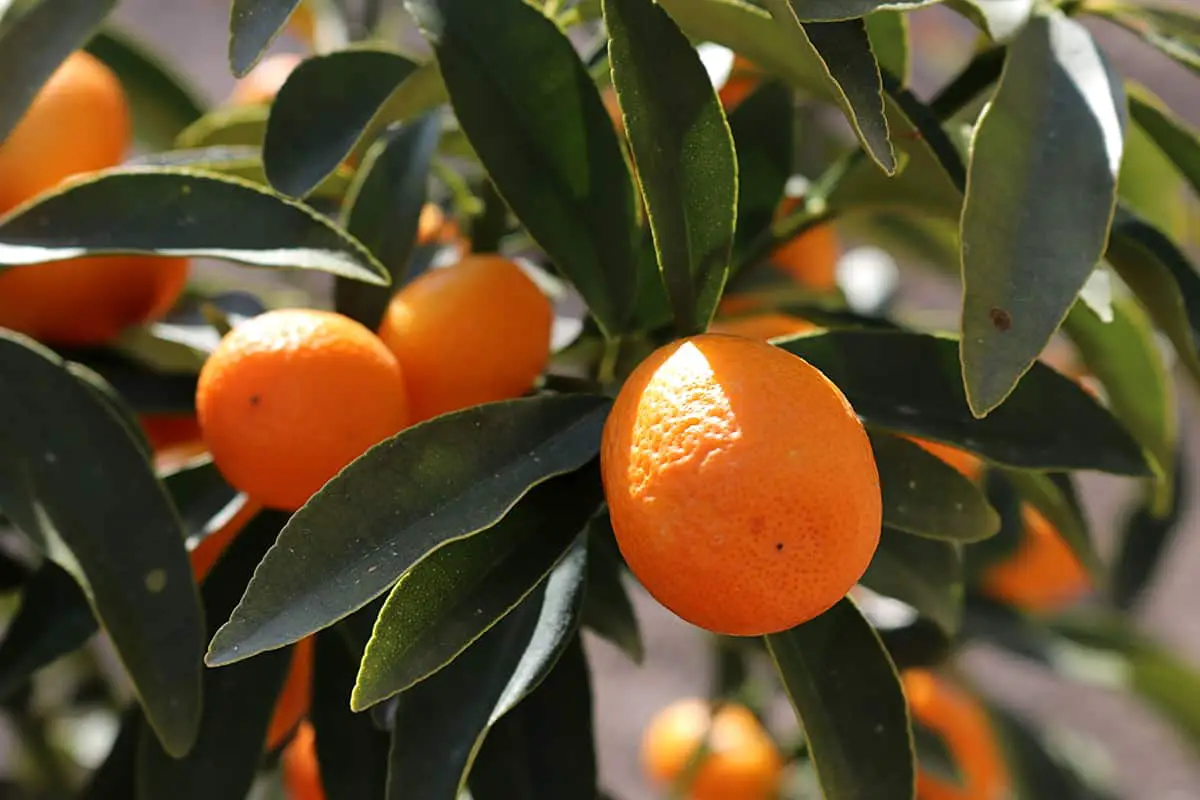
- Botanical name: Citrus japonica
- Common names: Kumquat tree,
- Plant family: Rutaceae
- USDA hardiness zone: 9 – 11
- Mature height: Up to 8 feet
- Mature spread: Up to 6 feet
The Kumquat tree is a small evergreen that is remarkably hardy for a member of the citrus family, being able to tolerate temperatures as low as 18°F. This is a highly attractive tree that is grown for its fruits, as well as an ornamental specimen for its appealing foliage and glossy, colorful berries.
The leaves of the Kumquat tree are shiny and lance-shaped, and they are held tightly together on the branches to give the tree a very lush look. The tree blooms in summer with white blossoms that are heavily aromatic. By winter, the flowers develop into small berry-like fruits around the size of olives. Since the flowers are self-fertile, they don’t need to be cross-pollinated.
Despite being a part of the citrus family and looking like miniature oranges, Kumquat fruits are actually modified berries. They have glossy outer skin, which shines against the green foliage in bright tangerine orange. The whole of the kumquat fruit is edible, including the skin. Most kumquats have sweet skin that covers a sour inner flesh.
Kumquat trees grow best in full sun. They need to be kept in well-draining soils, which are given frequent moisture but are not consistently wet or soggy.
Australian Laurel
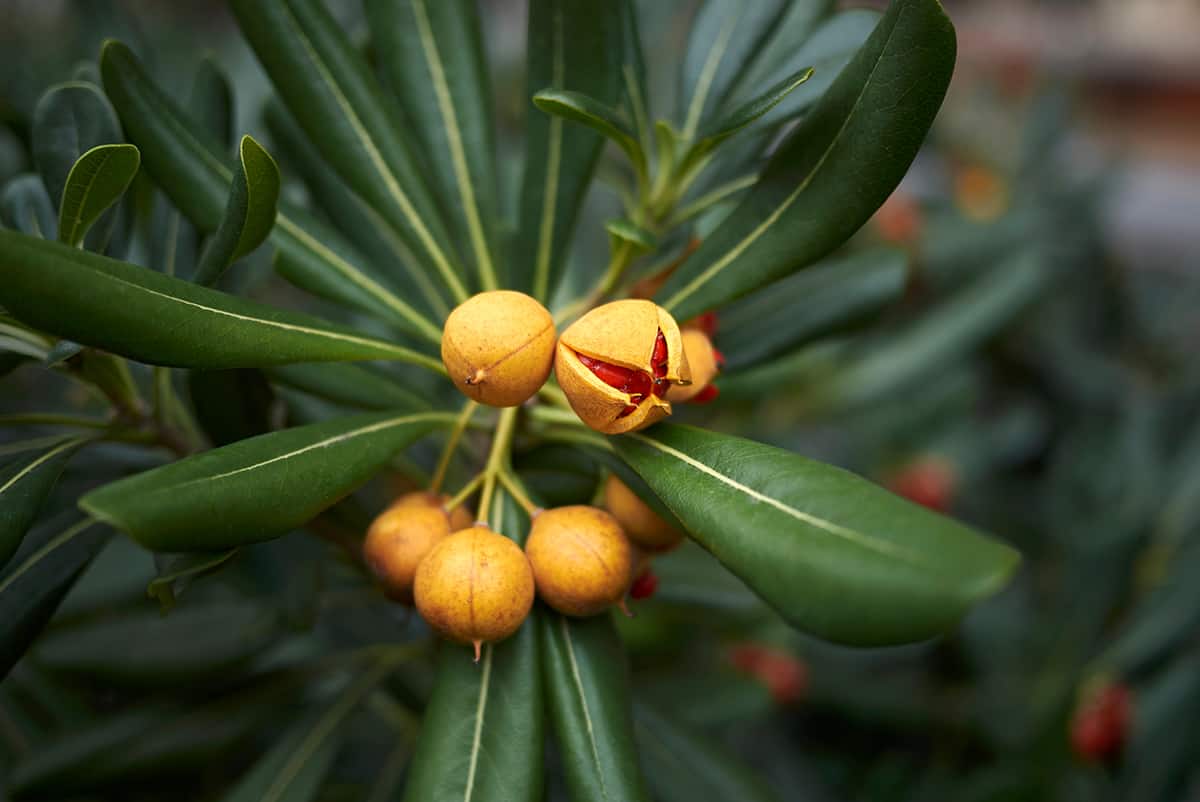
- Botanical name: Pittosporum undulatum
- Common names: Australian Laurel, Australian Cheesewood, Mock Orange, Native Daphne, Sweet Pittosporum, Victorian Box, Orange Berry Pittosporum
- Plant family: Pittosporaceae
- USDA hardiness zone: 9 – 11
- Mature height: Up to 40 feet
- Mature spread: Up to 25 feet
The Australian Laurel tree is native to Australia, but it has become invasive in some regions of Australia where it did not grow natively. It is a fast-growing, evergreen tree. The leaves of the Australian Laurel are thick and ovate, with lightly ruffled margins.
The tree is in flower from spring right through to summer, blooming clusters of small white blossoms. The flowers emit a strong fragrance through the night, which is similar to the scent of oranges and gave rise to the common name for the tree of ‘Mock Orange’.
The flowers are primarily pollinated by moths and butterflies. The flowers develop into small orange fruits, held in small clusters. Each orange berry measures around a quarter of an inch across, and these will remain on the tree into winter.
Australian Laurel prefers well-draining soil types, but it will also grow in sandy or loamy soils. It can grow in full sun or partial shade, preferring woodland locations.
Wild Cherry
- Botanical name: Prunus cerasus
- Common names: Wild Cherry, Sour Cherry, Tart Cherry
- Plant family: Rosaceae
- USDA hardiness zone: 5 – 9
- Mature height: Up to 30 feet
- Mature spread: Up to 20 feet
The Wild Cherry is native to Europe and Asia but is now widely grown in temperate regions around the world, most notably in North America. The Wild Cherry is a deciduous tree with spreading branches that form a loosely rounded canopy. The tree flowers heavily in the middle of spring, often before the new leaves have unfurled.
White flowers cover the bare branches, putting on a striking visual display. The flowers develop into berries by mid-summer, which start out golden yellow and intensify to bright orange before finally ripening into a deep shade of red.
The berries contrast beautifully against the backdrop of dark green, leather-like leaves. The wild cherry fruits are very popular with birds and other wildlife, so they should be protected if you are growing the cherries to consume yourself. These are sourer than sweet cherries, with a sharp, tart taste. They are best used in cherry pies or in the making of jams and preserves.
Wild Cherry trees perform best in full sun, but they can also adapt to some partial shade. They prefer moist soils, which are fertile and well-draining, but poor soils can also be tolerated.
Narrowleaf Firethorn

- Botanical name: Pyracantha angustifolia
- Common names: Slender Firethorn, Narrowleaf Firethorn, Woolly Firethorn
- Plant family: Rosaceae
- USDA hardiness zone: 5 – 9
- Mature height: Up to 15 feet
- Mature spread: Up to 10 feet
The Narrowleaf Firethorn is native to China and grows widely across Australia and North America as an introduced species. It can grow aggressively and is now considered an invasive species in Hawaii. Narrowleaf Firethorn is an evergreen plant that can be grown as a medium to large shrub or small tree.
They produce dark green, lance-shaped leaves which have shiny surfaces and are held tightly together along spiny branches.
Masses of white flowers arrive in the middle of summer, held in dense clusters. These develop into enormous numbers of berries, which ripen in the fall to shades of bright orange. The Narrowleaf Firethorn is attractive through every season and can also work practically as a hedge or privacy screen, which is impenetrable.
Narrowleaf Firethorn grows in full sun or partial shade and is tolerant of a wide range of soil types. It can survive drought but doesn’t fare well in wet conditions.
